Hiring has never been more challenging, and the global shortage of skilled workers is a big reason why. There are simply more jobs than people to fill them, and companies everywhere are competing for the same talent. But that’s only part of the story.
Our State of Hiring in 2025 report, based on data from over 5,000 companies worldwide, uncovers even more pressures weighing on hiring teams. Two stand out:
- First, a huge share of candidates give up before they even finish applying, with 41.2% of applications abandoned halfway through.
- Second, fewer and fewer career site visits are turning into actual applications, with conversion rates dropping across industries. Put simply, too many candidates don’t feel engaged or supported, and they’re walking away.
The good news? These challenges aren’t unsolvable. In this article, we’ll dig into what’s driving candidate drop-off and how you can tackle the biggest hiring pain points:
- Finding qualified candidates: Why it feels harder than ever to source the right talent, and what can help.
- Candidate experience: How to keep candidates engaged and supported, so they don’t drop out before hitting “apply.”
Report Data & Methodology
- This analysis is based on recruiting data from 5,649 companies, 259,000 job postings, and more than 8 million applications.
- The data was collected and anonymized in 2024 through the Tellent Recruitee app.
- The findings reflect trends across the global job market, including Europe (DACH, Benelux, France) and regions worldwide.
- The report examines key areas, including work models, recruiting efficiency, employer branding, career site performance, application drop-off rates, and conversion rates.
What the data reveals about today’s hiring challenges
The numbers paint a clear picture: hiring teams everywhere face real challenges that slow down how quickly—and effectively—they can bring in talent. What makes this report stand out is its global scope. Data from thousands of companies worldwide gives recruiters the hard evidence they need to back up what they’re seeing on the ground, win stakeholder buy-in, and push for meaningful change inside their organizations.
Here’s a look at some of the key findings:
Turning visits into applications
Our research shows major differences in how well career sites convert visitors into applicants. In the Benelux and DACH regions, fewer than 1 in 20 visitors apply, with conversion rates below 5%. In France, conversion jumps to 10.4%, and across the rest of the world it’s even higher at 11.6%.

Companies in some regions are leaving a significant share of potential applicants on the table. The gap often comes down to avoidable frictions: unclear job descriptions, lengthy or desktop-only application forms, and slow communication all discourage candidates from finishing an application. By contrast, regions with higher conversion rates make the process simple and transparent: candidates know what’s expected, can apply on mobile in just a few clicks, and receive timely updates.
The lesson is clear: improving the candidate experience directly boosts conversion. Streamlining applications, optimizing for mobile, and setting clear expectations can help turn more curious visitors into engaged applicants.

Application form drop-off remains high
Our research highlights another major challenge: keeping candidates engaged long enough to complete an application. More than 40% of applications are abandoned before submission—meaning nearly half of interested candidates never make it past the form.
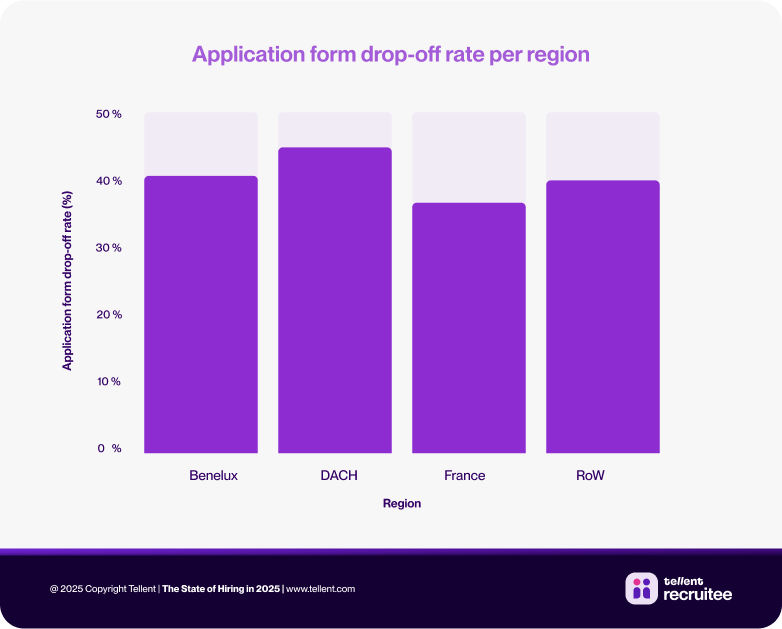
Why does this happen? Often, the culprit is usability. Even when candidates are motivated enough to explore a career site, poor navigation, long forms, or clunky design create friction that stops them from finishing. By contrast, a smooth, mobile-friendly experience keeps momentum going and dramatically increases the chances that candidates will hit “submit.”
“Candidates expect the application process to be quick, mobile-friendly and simple. Long forms or clunky software put them off." Jan Steffen, Managing Partner at eTo Recruitment Marketing
Interestingly, our data shows that larger organizations often provide a stronger application experience thanks to more polished sites and streamlined processes. For smaller and mid-sized companies, this is both a challenge and an opportunity. By prioritizing usability and removing barriers, they can close the gap and stay competitive in the fight for talent.
Hiring still takes too long
Speed is another critical challenge. Globally, the average time to hire is 40.1 days—more than five weeks to fill a single role. Larger companies, with more resources and structured processes, move faster, on average, at just 28 days.
At first glance, those numbers may not seem alarming. But every extra week slows down business growth and raises the risk of losing top candidates to competitors. The data also shows an average of 5.5 interviews per hire worldwide, a clear sign that many processes are still drawn out longer than they need to be.
The lesson is clear: faster, more focused processes win talent. Companies that cut back unnecessary interview rounds, set clear evaluation criteria upfront, and move quickly when the right candidate appears are far more likely to secure top hires before someone else does.
Timing shapes results
Our research shows that when you hire can be just as important as how you hire:
- Global trends: Most job postings happen in October and November. In Europe, that timing aligns with peak candidate activity, but in other regions, the busiest job-hunting season isn’t until February—creating a mismatch and missed opportunities.
- Daily patterns: Recruiters often post later in the week, while candidate activity peaks on Mondays and Tuesdays. Weekends also see steady application traffic even though few new jobs appear then.
Smart timing matters. Posting earlier in the week and aligning job ads with peak activity gives openings more visibility. Pair that with a strong employer brand and proactive outreach, and you’ll keep candidates engaged all year long—not just during seasonal spikes.
“We can’t wait for the right candidates to be actively looking; we need to go out and find them, work on our employer brand on an ongoing basis, and not depend solely on the times when there are more candidates on the market.” Jessica Djeziri, Head of HR at Bloomays
What to do next: best practices for recruiters
Our State of Hiring report doesn’t just highlight the challenges—it also shows what to do about them. Based on insights from thousands of companies worldwide, we’ve put together a practical action plan to help recruiters attract and win top talent in 2025.
Here are five best practices for you to try out:
1. Keep your job ads crystal clear
When writing a job ad, always put yourself in the candidate’s shoes. What do they actually need to know? Clarity matters.
For example, one of the biggest frustrations candidates share on platforms like LinkedIn is discovering after several interview rounds that a role labeled “remote” actually requires frequent office presence. In today’s job market:
- 72.7% of jobs are hybrid
- 21% of employees prefer fully remote roles
- When expectations don’t match, suitable candidates are 14% more likely to drop out late in the hiring process
It’s also important to use very clear language in the job description. Avoid using generic phrases like “dynamic work environment” or “challenging tasks.” Candidates want the truth. Show them what a typical day looks like, the tools they’ll be working with, and how you’ll set them up for success during onboarding.
Honest, specific job ads attract more of the right candidates and keep them engaged all the way through.

2. Optimize your careers page
A strong, candidate-focused careers page is one of the most valuable assets recruiters have. It’s often the very first impression candidates get of your company, so it needs to count. That means ditching stock photos and generic slogans.
Instead, show the real story: authentic voices, real employee experiences, and a clear sense of what it’s like to work at your organization.
A careers page that feels genuine and human does more than attract applicants—it builds trust and sets the tone for the entire candidate journey.
Want to revamp your careers page? Read our step-by-step guide on how to create a careers site
3. Make application forms much more user-friendly
Few things frustrate candidates more than being asked to type the same details again and again. If all the information is already on their CV, why should they re-enter it? When application forms feel repetitive or time-consuming, many candidates simply give up.
The solution is straightforward: cut required fields to the essentials and use tools to do the heavy lifting. Resume parsers can automatically extract details from PDFs, while one-click applications or LinkedIn integrations make applying seamless.
Streamlining forms not only speeds up the process, but it also sends a powerful signal that your company respects candidates’ time. This makes them far more likely to finish their applications.
“Something as simple as letting candidates apply right from the job detail page can help reduce drop-offs. For flexibility, it still makes sense to offer other options, like applying via Indeed, WhatsApp or other platforms, but the easiest path should always be front and center.” Sera Mbaraka, Recruiter at The Görgens Group (Olymp & Hades)

4. Make mobile-first a priority
Most job searches now start on a phone. That means your careers page and application forms need to be just as smooth on mobile as they are on desktop.
- Pages should load quickly,
- layouts should adapt automatically, and
- navigation should be intuitive.
If candidates have to zoom, scroll endlessly or fight with annoying fields or pop-ups, they’ll be gone before they ever reach “Apply.”
5. Build a unique employer brand
You don’t have to wait until candidates are actively job hunting to get their attention. Show them what it’s like to work with you long before they start browsing listings.
A quick Instagram reel from a team event, a LinkedIn post about onboarding, or a short behind-the-scenes video are way more meaningful (and persuasive) than a polished ad campaign.
The key is consistency. Employer branding is not a one-off project: it’s an ongoing effort. Meet your audience where they already spend time, share content that feels real, and don’t be afraid to get creative. Done well, it builds trust and keeps your company top of mind when candidates are ready to apply.

Putting candidates first matters now more than ever. Build your recruitment process around their perspective. Keep applications simple, remove unnecessary barriers, and ask regularly for feedback so you know what’s working and where to improve.
Want to know more about candidate experience? Download our free checklist today
Real-World examples: recruitment success stories
Sometimes it only takes small changes to stand out from the crowd and make real lasting impressions on candidates. Here are a few examples of how companies are using simple but powerful tactics to spark interest and come across authentically.
Clear roadmap in job postings
Tellent picked up on what candidates were asking for: crystal-clear information about the job. Our job postings now outline what new hires can expect in their first three months, after six months, and after a year. This gives a realistic picture of how the role develops over time, while also building confidence and trust.
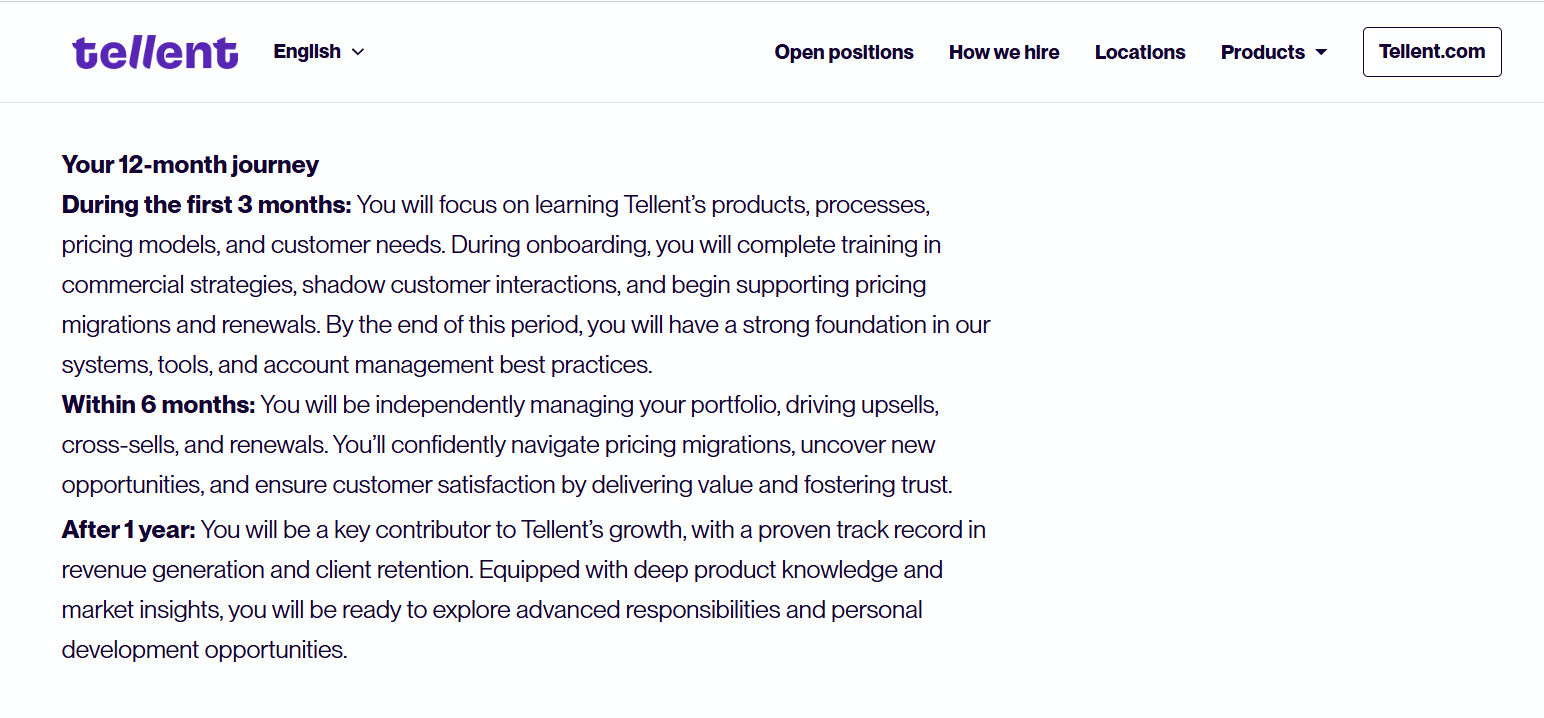
A careers page that feels like a community
Swapfiets, the subscription-based bike service, has built a careers page that goes beyond job listings. Jobs are grouped by teams, making it easy for candidates to explore where they might fit best. The page also highlights the company’s mission, values, and sustainability commitments, showing applicants they’d be joining a purpose-driven brand. Authentic employee stories and vibrant visuals bring the culture to life, while clear navigation and a simple application flow remove unnecessary friction.
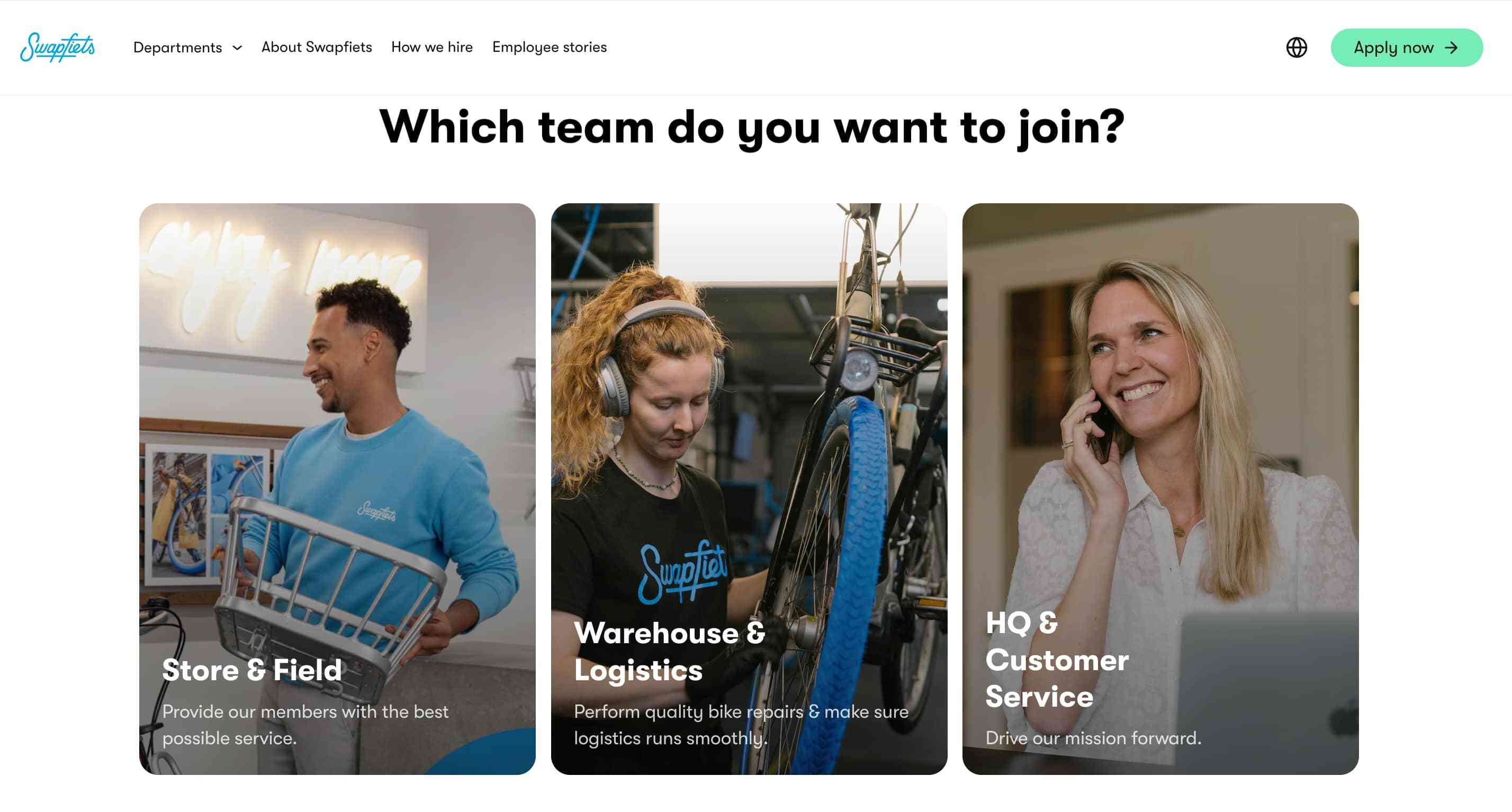
By blending transparency, usability, and culture storytelling, Swapfiets creates a candidate experience that feels both engaging and authentic—reducing drop-offs and building stronger connections with the right talent.
Making the application journey clear
Teamleader, the fast-growing SaaS company for SMEs, uses its careers page to combine strong branding with a smooth candidate experience.
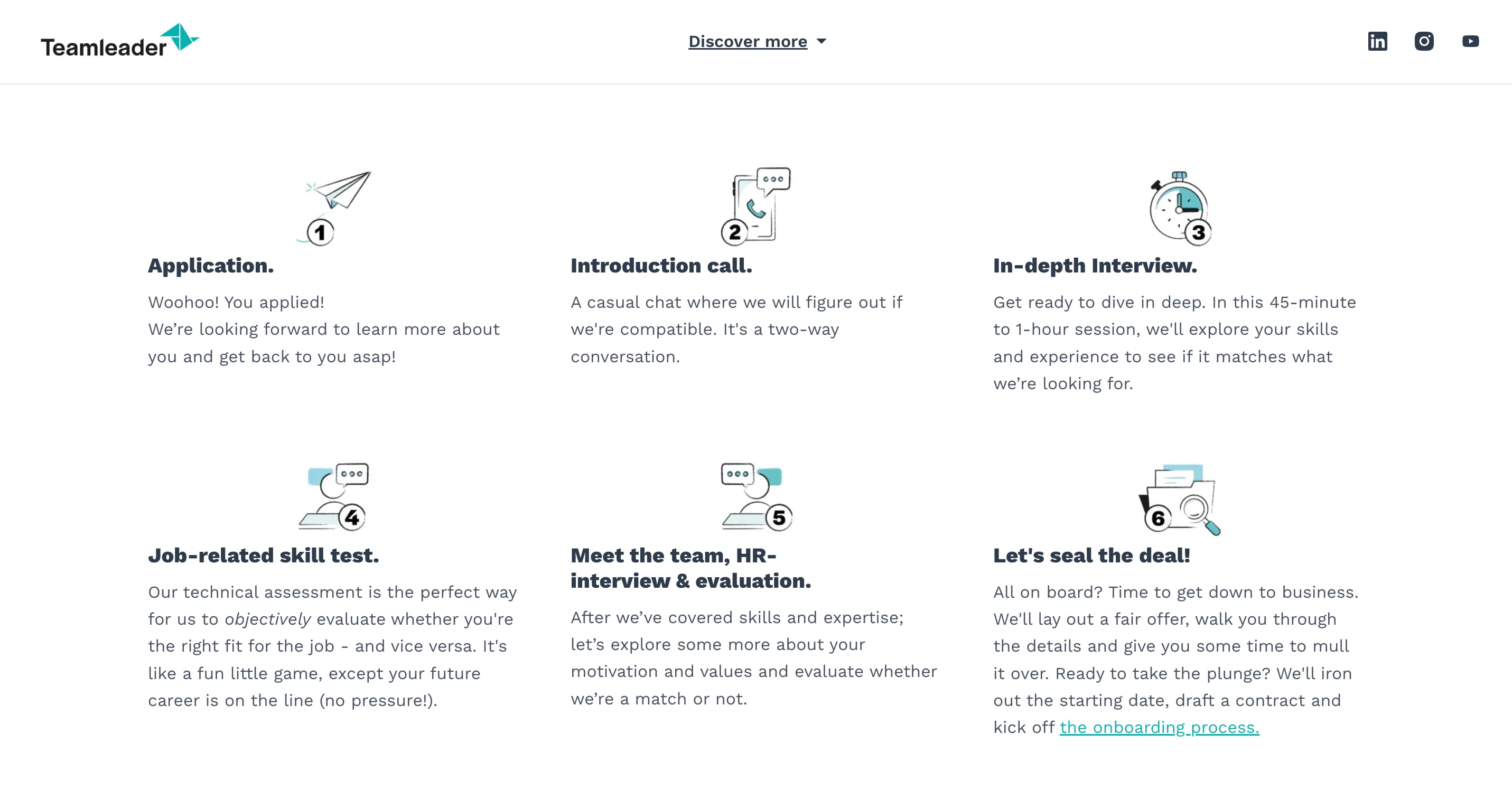
What really stands out is how Teamleader maps the entire application process visually. It’s a small detail, but one that makes a big difference: candidates know exactly what to expect at each step, which builds trust and reduces uncertainty. The result is a careers page that not only looks good but also makes applying feel transparent and straightforward.
Conclusion: put candidates at the center and get the basics right
Successful recruiting in 2025 won’t come from chasing short-lived trends or the latest hype. Our research shows that the biggest opportunities lie in fixing the fundamentals—and putting candidates at the center of every step.
That means writing clear and transparent job ads, building careers pages with relevant content, intuitive navigation, and mobile-first design, keeping application forms short and simple, and making employer branding real by showing authentic insights, not polished slogans.
The formula isn’t complicated: when you view the entire recruiting process through the candidate’s eyes, you naturally remove barriers, build trust, and attract the right people faster.
“In the next few years, recruiting will have to focus even more on putting candidates first. It’s about finding a real match on both sides, because that’s the only way to build lasting performance and business success.” Malin Gereke, Head of HR Strategy at Blume 2000
Want to dive deeper? Discover more insights, benchmarks, and best practices in our free State of Hiring 2025 report, based on data from over 5,000 companies worldwide. Download it today!
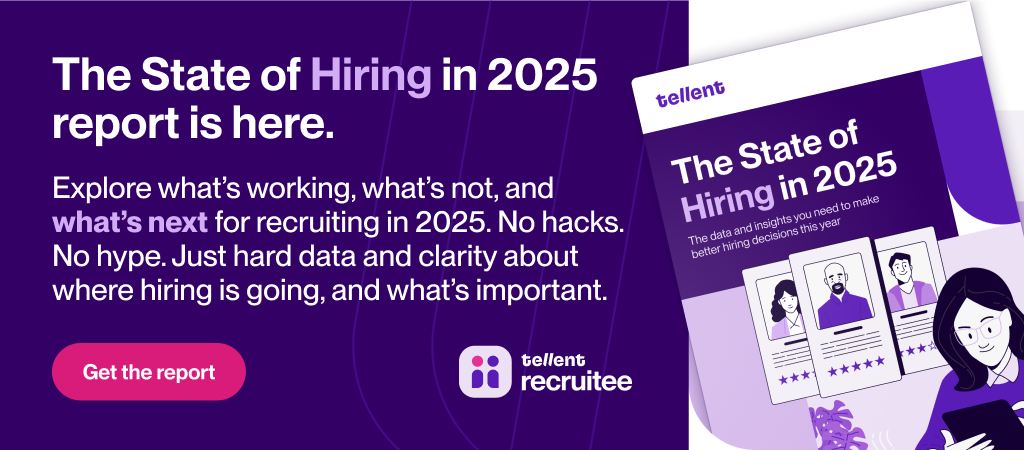



.jpg?width=1000&name=68dcf46e0449bcd850be62bb_%5BEN%5D%20Blog%20header%20-%20Whatsapp%20hiring%20(1).jpg)
.jpg?width=1000&name=66dad5ff73bd7019883f0a32_white-details-of-puzzle-on-yellow-background-busi-2021-12-21-18-51-46-utc%20(1).jpg)



